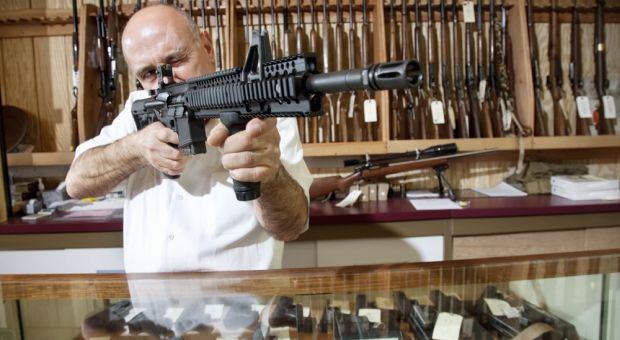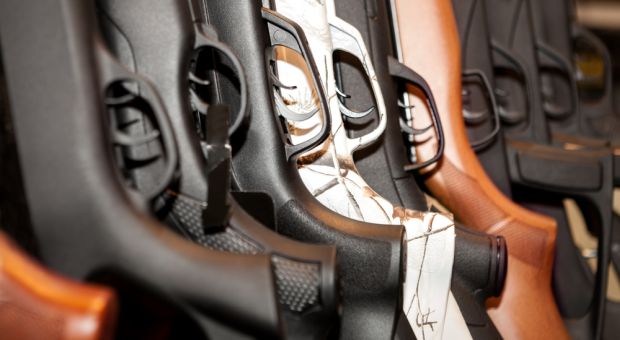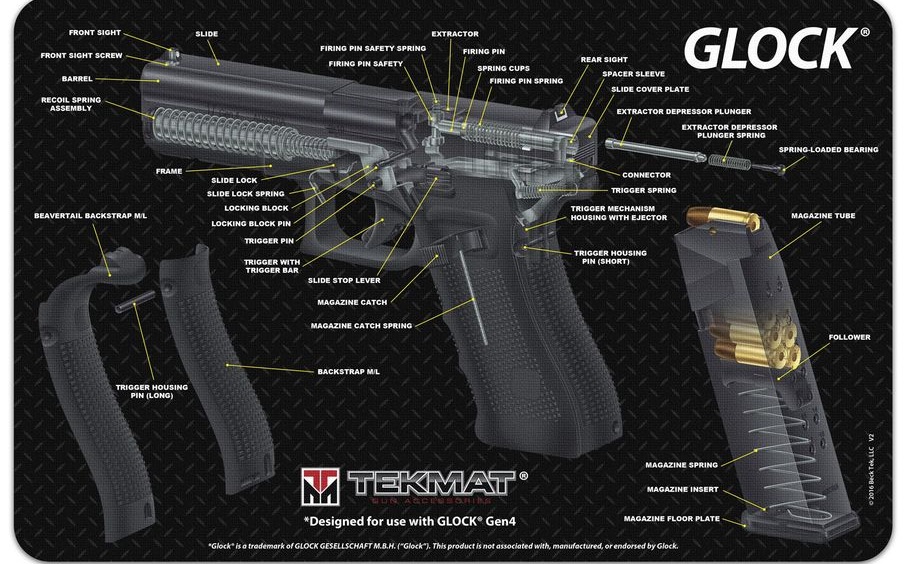You’ve seen in the news how criminals are getting fearless and how break-ins are becoming a common occurrence. Seeing how things are unfolding and hearing stories from neighbors and friends about unpleasant encounters with the criminal element are probably the main reasons you decide to get a firearm.
You are one step closer to keeping your family safe, but you still have to decide if you should go with a handgun, automatic rifle, or shotgun. You ask around, and you notice that everyone has a strong opinion regarding one of the three weapon systems, and even if the final choice is yours, there are still some questions you need to ask yourself. So before you ask your gun supplier which firearm he recommends, you should do a little bit of research on your own.
The weapon system you use can make the difference between life and death during a home invasion. Each firearm has advantages and disadvantages in your home environment, and we should look into this before you decide what gun you’ll get.
Accessibility
A good home defense firearm needs to be readily available to do its job. So you can imagine that from all three weapon systems named above, the handgun is the most accessible of them all during a situation when you may have to face a lethal encounter.
You could store your loaded handgun on your nightstand in a lockbox or in one of those household items that conceal the presence of a gun (like a tissue box with a hidden gun compartment). Then, your handgun would be in reach when you need it the most. Even more, you can store it anywhere in your home without significant issues.
A loaded shotgun or rifle, on the other hand, needs to be stored in a safe, or at least that’s what any responsible gun owner should do. This means you would need time to get it, and in certain situations, you may not have that luxury. Even more, keeping your long guns around your house during your daily routine is cumbersome, and your family members may get uneasy. On the other hand, you can carry your handgun on you at all times.
The same goes for ammunition, and it’s much easier to handle this issue when it comes to handguns due to the size of the rounds and the magazines’ size. So you can carry extra ammunition (and you’ll probably have to) on you without any issues.
Considering the reasonably limited capacity of a hand’s gun magazine compared to most automatic rifles that have approximately 30 rounds, you should consider keeping an extra magazine or two for your handgun on you at all times.
As for shotgun rounds, the ammunition limitations need to be addressed since the rounds are heavy and bulky. In addition, these firearms have a limited magazine capacity of approximately six rounds, and they are much more time-consuming to load compared to the other two weapon systems.
And when we talk about firearms accessibility in a home defense scenario, we also have to include the other family members in the big picture. So the user-friendliness of the firearm you chose for home defense is an important aspect you have to keep in mind since you probably won’t be home all the time.
In that case, other family members will be in charge of protecting the fort. Seeing that everyone is different in strength and physical abilities, you can understand how user-friendliness plays an essential role in operating a firearm.
Since handguns are the smallest and lightest of the three weapon systems, these make them a better choice for sharing between family members who have different body types and are less physical in their daily lives.
Maneuverability and functionality
Handguns are the easiest to maneuver in an environment where doors and doorways, small rooms, tight corners, nooks, staircase, and furniture are ever-present problems. Moreover, handguns are the easiest weapon system to wield when such obstacles are an obstruction. Even more, it’s much easier to retract a handgun compared to a long gun to prevent a gun grab.
Another strong point of handguns is the owner’s ability to operate them using one hand. This gives him advantages like calling 911, opening doors, carrying a flashlight, or even assist family members in case needed. Even if one of your arms gets injured, you will still operate the handgun without significant drawbacks. You can imagine that it wouldn’t be so efficiently using a shotgun or an automatic rifle with only one functioning arm.
Distance also plays a key role when sighting in on an assailant, and it’s much easier doing so with a handgun at close range. However, rifles are more accurate than any handgun when distance is involved. Only lots of hours at the range can fix this weakness. When sighting using a gun, one thing to keep in mind is that specific scopes can inhibit your close-range sighting abilities within a room.
Shotguns are hard to maneuver in small areas and, in general, are too heavy for most people. Not to mention that even if they have the best hit potential in low-light settings, the prohibitive recoil impulse makes them unfit for most folks.
When it comes to shotguns, if you decide to go with this firearm, you should consider the shot spray and how it affects the outcome of an armed confrontation, considering the load and the distance between yourself and the target. While at close range, the shot spray can be no wider than a fist; the spray will often be more comprehensive than the home intruder at a longer range.
This has two outcomes: insufficient pellets hitting the target leading to failure to incapacitate the attacker, or you could hit innocent bystanders. Both of these scenarios will lead to a tragic outcome.
The blast and recoil of each of the three weapon systems described in this article need to be considered as well. For example, most people can easily manage the recoil impulse and the blast from a handgun. However, when it comes to shotguns and rifles, there are always problems we need to acknowledge.
Firing a rifle or shotgun indoors creates a powerful blast that can stun and disorient the inhabitants finding themselves in close vicinity to the person operating the firearm. Even more, the larger the blast, the bigger the chances of hampering your night vision right when you need it the most.
Stopping power
In most cases, home invasions involve multiple opponents. When it comes to numbers working against you, stopping more than one home invader is much more difficult with a handgun than with a shotgun or rifle.
There could be more of them than there are of you, they could be spaced throughout the house, and they could constantly be moving. They have their weapons of choice ready, and they also have the element of surprise on their side. You can see how all of this creates a huge tactical advantage for your opponents.
That advantage cannot be successfully countered by a single person firing a handgun unless that person is very well trained. More precisely, stopping power comes into play in such scenarios, the round’s reliability to destroy the opponents. And here, nothing beats the trustworthiness of shotguns and rifles when it comes to home defense.
Let’s say you are proficient in using a firearm, and you’ve put in the hours at the range. Yet, even with all your training, the chances are high that you need to take several shots to stop an attacker. Even more, things such as barriers, body armor, shot placement, and even drugs come into play and have a decisive role in establishing the outcome of a confrontation.
With a rifle, the round will most certainly go through most obstacles (including people), and it will do a lot of damage. This is why in armed conflicts of the world, rifles are the main firearms of choice, and handguns are just the means to get to the rifle if one is not readily available.
That being said, there is the need to consider the over-penetration issue if you decide to go with a rifle. Some standard handgun rounds can indeed penetrate most interior doors, but when it comes to rifle rounds (depending on the round being fired), these can shoot through your opponent and walls within your home with ease. Even more, they will go through common walls between apartments, and you may hit innocent people.
Let’s look at the case where an owner uses a shotgun loaded with 00 bucks for home defense purposes. Each pull of the trigger will release nine .38 caliber pellets, but the effective range will be shorter than a handgun or rifle. Some will train using the “select slug” technique to extend that range, but not everyone can master such a drill.
As engagement goes, that 00 bucks may very well hit the head, groin, or knee areas, which may cover the body armor issue if your attacker is using such protection. People agree that even poor hits can incapacitate the attacker since severe wounds are inflicted with each shot, but as said before, the spray issue comes into play.
The best stopping power of shotgun is achieved at close range with 12-gauge buckshot, but you also have to consider that such round has the heaviest recoil impulse. Even more, statistics show that a shotgun round loses up to 70 percent of its effectiveness at 30 years (this depends on the barrel and round being used). Thus, you can see how long-range will become an issue if you don’t manage to master the special slug technique when the time comes.
Some argue that rifles and shotguns are the most intimidating in assailants’ eyes and that the sole “racking” of a shotgun is enough to deter any would-be attacker. However, I don’t think handguns should be seen as less intimidating tools of home defense. While not as visually impacting as riles and shotguns, a handgun can still deter any home opponent if used correctly.
What does that mean?
Well, anyone that has experience in dealing with firearms can tell the difference if you’ve drawn your gun ten times or hundreds of times. But, of course, posture and attitude are also factoring in your favor, so you can imagine that putting in those hours at the range will pay off in the end.
Budgeting issues
Some people consider the price factor when picking a weapon system for home defense, and budgeting issues are often present in a gun owner’s life. That being said, handguns are the least expensive option for any homeowner out there.
A budget of $500 to $800 can get you a good quality handgun regardless if you like to go with a pistol or a revolver. Shotguns are more expensive, and a good shotgun can cost you more than $1,000. As for rifles, any good quality starts at around $1,000, although cheaper deals can also be found.
Some may argue that their “gun guy” will give them a better deal than the numbers listed above, but the critical factor when buying a weapon for home defense is quality. Good quality is the way to go since it’s like buying insurance for your home. There’s no room to cheap out, and you have to be covered in every aspect when it comes to your home’s protection.
In the end, it’s your call, and after thorough research, you should be able to buy the best quality weapon you can afford.
Training becomes mandatory
Training with your weapon of choice is mandatory, and you aren’t buying a gun to lock it in a safe to get it out when the time calls for it. When it comes to training, you should know that handguns require fewer training hours than other weapon systems and are much easier to operate. Some people become outstanding and accurate with handguns, just with a minimum amount of practice.
Learning the system of a rifle as a whole will require more time even though, at first, it may seem relatively easy to aim and fire using the said rifle.
I think that shotguns are the most complex of the three when it comes to home defense training. That is because they require much more hours to be put in to exploit their full speed, power, and accuracy potential.
Leaving aside the need to learn the “select slug” technique, it is essential to acknowledge that malfunctions occur much more often with shotguns if the operator is not well trained. Adding the recoil and weight issue, plus the reloading techniques that need to be mastered, you can see why shotguns require much more training hours compared to rifles and handguns.
Concluding
After reading this article, the reader should understand that picking one or more firearms for home defense purposes is a much more complex subject than initially thought. If that’s the case, my job is done, and you should have acknowledged that this is not a decision to take lightly.
Some will go with all three weapon systems just because they can afford to do so, but in my opinion, that won’t help when the alarm goes off if you don’t know the limitation of each firearm you are wielding and if you didn’t put in the training hours.
Also, you should read Simple Gun Hacks That Will Instantly Double Your Accuracy from Decorated Green Beret!




No comments:
Post a Comment